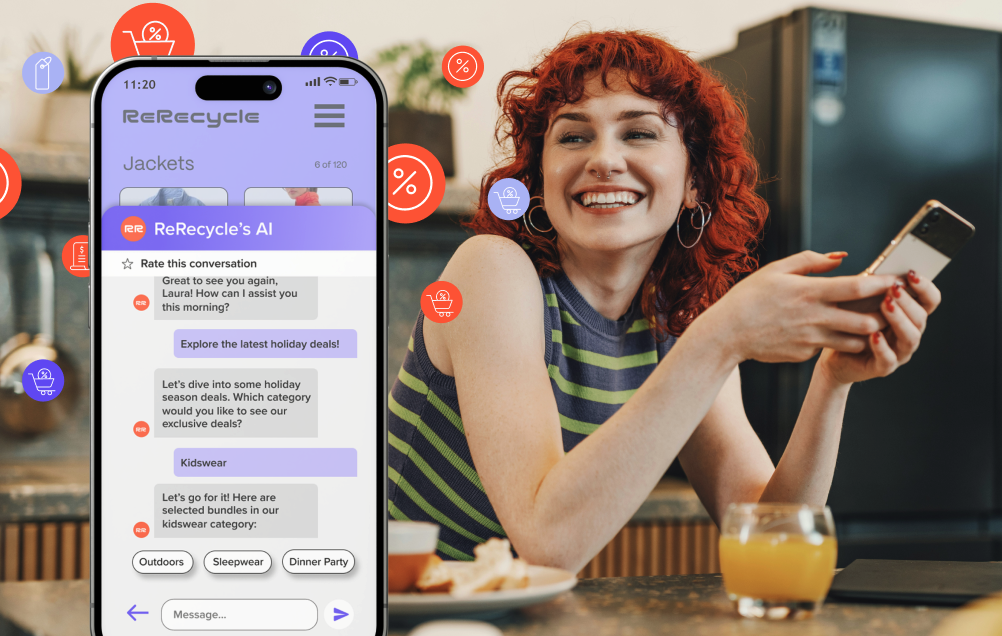AI for Shopify: How Rep Turned The Chatbot Into A Sales Machine
How well does AI sell on Shopify? We’ve got numbers.
Hi. I’m Paul, and I do marketing at Rep. Today, I’ll be your reporter for this particular article to share how well Rep has performed at its number one task: selling.
So the question isn’t, “Can AI sell?” — because it does. The question is, “How well does AI sell?” while still making your brand look good.
A few notes before we get started:
- At Rep, we view selling as ‘personalized service’ because great, attentive service drives eCommerce sales.
- We call the chatbot a ‘concierge’ because concierge evokes the highest level of personalized service we want Rep to emulate.
- We make a distinction between shoppers and customers. Shoppers are in buy-mode and customers have bought before. Can customers become shoppers again? Absolutely. However, Rep’s emphasis is to turn shoppers into buyers—or customers.
- AI is still early-ish, but I will constantly stress that this is the worst AI will get. AI’s ascendence will only continue, even though the ‘AI’ moniker will fade to the background at some point—because everything will be AI soon.
- This article's case studies, brands, and quotes are real. In many cases, I wanted to get out of the way and let clients speak for themselves.
Let’s begin.
2023 Results
Who knew what was possible when the year began? OpenAI launched its flagship model, ChatGPT, in November, quickly reaching 1 million users within five days of its launch.
By January 2023, 100 million users were using it, and it was not slowing down—it was the fastest-growing product of all time—until Meta launched Threads.
In 2022, Rep also deployed its own behavioral AI, which became the cornerstone of our current AI model.
As we integrated OpenAI’s ChatGPT into Rep’s AI model, it took some time to tame and train Rep to do the following well:
- Represent your brand (personality, voice, market, etc.)
- Be your product catalog expert—consistently
- Sell more by assisting shoppers proactively (initiate chats, recommend products, respond contextually, etc.)
It’s been challenging building Rep into what it is today, but the results have blown us away. Again, I want to remind you that this is the worst AI will get in its current sales role for Shopify and eCommerce.
Here are the numbers—I’ll let the graphics speak for themselves:







Not bad, right? Of course, we want to thank all the early adopters of this technology because without them, how could we possibly know if AI can live up to its sales promise?
But the story doesn’t stop there. It’s just beginning. Because the things we’re noticing—what our clients are experiencing—are so unexpectedly good that it’s time we share those results.
But all this AI goodness naturally follows the problems it solves—problems that have plagued Shopify and eCommerce owners since their stores opened.
So, how does a front-facing AI—like Rep’s AI Concierge—solve some of eCommerce’s most persistent problems? The answers might surprise you.
A solution to eCommerce’s most persistent problems
So, how does Rep tackle eCommerce’s long-standing problems? Consider these sticky challenges:
- No presence to attend to shopper needs and questions
- The 98% Problem, i.e. low conversions on site visitors
- Helping shoppers find and discover new products
- Abandoned carts
- Low shopper confidence
- Upselling or cross-selling (the AOV problem)
- Engagement beyond purchase
- Support ticket overwhelm

Let’s see how merchants have solved each using Rep AI.
No presence in your online store

Normally, when you shop online, nobody is there to support your shopping experience.
No assistance. Nobody to answer your questions. No product expert to explain things.
Shoppers came to expect this experience after some time, but having no presence remains a huge problem. Why? Because shoppers have questions, doubts to assuage, and fears to ease.
Rules-based or scripted chatbots can’t solve this problem. Pop-ups certainly didn’t help. But AI infused the old chatbot interface with a little personality and lots of product knowledge.
Now anyone has access to an intelligent AI concierge for Shopify that understands:
- Your catalog—probably better than you the bigger or more complex it gets
- Your market and how it should speak to customers
- Your brand identity so it maintains your unique edge
Before, shoppers browsed around an empty store with dumb pop-ups yelling for attention. Now, an intelligent sales concierge is there to guide people (who need it) all the way from browser to buyer.
For merchants, they have an active, attentive presence in their shops. AI transformed the world of eCommerce overnight.
The 98% Problem or the conversion problem

According to Shopify’s numbers, the average eCommerce store converts site visitors at a 1-3% clip—again, that’s your average eCommerce store.
Ouch.
Imagine spending all that money and effort getting people to show up to your store and having most of them leave soon after they arrive. Not good.
Rep developed a Behavioral Intelligence component in its model to counter this. Its job is simple: observe a site visitor's behavior, and if it looks like they might be wavering a bit, then proactively approach them, and start a conversation.
Behavioral Intelligence

True story. Our team initially thought that Rep should approach everyone. Before Behavioral Intelligence, our engineers developed a timed pop-up to approach shoppers at various intervals.
They tried ten seconds. Then, twenty seconds. Then, thirty seconds.
And guess what happened? Conversions went down. Like, embarrassingly worse than before.
Why? We figure because it’s interruptive, and I don’t know about you, but if I’m actively shopping online or in a physical store, I don’t want to be unnecessarily interrupted. This doesn’t mean approaching shoppers was a bad idea—it wasn’t. It was just poorly executed.
So our devs added Behavioral Intelligence (Bi) to the product. It could observe shopper behaviors and sense when people were disengaged in any way—which usually led to bounce rates spiking.
The Bi would assess a shopper’s probability of leaving the site, and once that seemed more likely, the conversational AI would kick in.
Interrupting people is the old way. Digital empathy is the new way.
Harney & Sons improved their overall conversion rate by 250%
Does it work? I give you Harney & Sons Fine Teas. I was working on their case study, and during our call, Emeric Harney told me that their store previously averaged a 7-8% conversion rate.
After Harney implemented Rep? They jumped into the 20% CVR range—a 250% increase according to them.

How? Why? Is this an outlier?
Even before this interview, I remembered Underoutfit reported that their conversions tripled.
Does it get those results for everyone? No—because your site UX, your products, your market, and so many other factors matter. But do conversions improve with AI, even if it’s a slight uptick? Yes.
Forget about tripling your site conversions for a moment. Would a 1% or 2% increase in conversions worth it to you? Now imagine 10% bumps in CVR. AI can make a difference.
Finding and discovering products

I want to stick with Harney because their ‘conversions’ problem was also tied to their ‘discovery’ problem. How do they use AI to increase discoverability for some of their more exotic teas on their Shopify?
What’s the difference between search and discovery? Well, ‘search’ is knowing what you’re looking for: “I want some green tea.”
And product discovery is more like: “Hey, I’m looking for a tea variety from Japan, Korea, or China. Any ideas?”
Not knowing what great tea varieties exist affects both the merchant and consumer. For the consumer, perhaps they miss out on an experience they would come to love. For the merchant, their catalogs become more constrained, limiting sales and growth into new markets.
So, Harney trained their AI to introduce shoppers to the latest flavors from Japan and South Korea—while people were shopping.
This is Emeric Harney in his own words:
“We have over 300 different types of tea and spend a decent amount of time building product descriptions and adding meta fields. These data have flavor notes, tasting profiles, and things like that. And even with all that information, showing people new and different products can still be hard. We have those category pages for single-estate teas from Japan or South Korea, but driving traffic there can be difficult. Now we have Rep to assist people interested in unflavored or flavored teas and guide them that way—that's huge for us.”
The conversational AI played an important role as well:
“Rep helped a lot in product discovery. For people to have an interactive layer for product discovery has been huge. We get amazing conversion rates. Our average conversion rate across devices is around seven and a half percent. So to have people converting in the 20% range from AI is great.”
Abandoned carts

Did you know that shoppers who add products to cart are 70% likely to abandon those carts, according to The Baymard Institute?
There are UX issues to fix, sure, but what can AI do about it? Chase shoppers and shake them down? Perhaps. How could AI help solve abandoned carts for Shopify?
Snow Teeth Whitening wanted to address this problem, explaining the difference to me between abandoned carts (having no contact info) and abandoned checkouts—where a shopper entered their credit card and email but didn’t complete the checkout process.
Snow had a simple process for ‘abandoned checkouts’: a Snow rep would contact the shopper and offer an incentive to purchase. But they didn’t have a solution for ‘abandoned carts’ and asked if Rep could take on this challenge.
So, the team developed something similar to Snow’s abandoned checkout solution. Here’s how it worked:
- A first-party cookie flagged Rep's AI whenever a shopper added something to the cart and left without leaving an email.
- From there, Rep approached shoppers while they were still on the site and incentivized them to complete their purchase.
The result? From Snow’s team:
“We implemented the abandoned cart flow in mid-July. About a month later, the conversion rate was 33.85%. And sales are $223,747 from that one flow. From an attribution standpoint, we would have gotten some of that revenue anyway, but somehow they interacted with AI and completed their purchase. It opened our eyes.”

Low shopper confidence

Low shopper confidence is nothing new. It’s the reason why:
- Conversions are lower for specific product categories
- People abandon carts
- First-time buyers are last-time shoppers
There are lots of reasons for shoppers to get cold feet. We don’t need to list them all here, but by having an AI presence in your store, you can effectively counter these issues with:
- Instant support or on-the-spot Q&A with a product expert
- Personalized recommendations or reassurance
- Sharing resources or research to boost confidence effectively
- Offer social proof like reviews, testimonials, or product use cases
For Vush Stimulation, their issue was their product category: sex toys. Sex elicits lots of mixed emotions, which heightens other issues like:
- Product sensitivity: First-time buyers might feel embarrassed or unsure about their purchase, which leads to hesitation.
- Ignorance: How do people know if a product is right for them and their body-mind type? Sex is a complicated issue, so more education is better.
- Taboo topcis: How do you make sex toys or ‘pleasurable devices’ more accessible with the broader cultural narratives around sex?

Using their blog and vast knowledge base, Vush trained Rep to educate and reassure customers. The result?
- 4x more traffic to their blog (the AI shared relevant articles as links within the chat itself)
- 10% increase in overall conversions
- Support tickets dropped, and so did the need for human intervention
According to Vush:
“Rep helped us get down to what it really is that each individual person needs when it looks like they’re exiting. We can put forward a couple of options, and they have the choice to say, ‘Hey, I’m a beginner, or I need some education,’ so we can help them embrace their journey and stay on site until they feel comfortable enough to buy”
Upselling or cross-selling (the AOV problem)

Rep has many examples of AI helping Shopify stores increase their overall AOV. Let’s be clear. It’s not just about recommending similar or complementary products—Rep does that, too, as we’ve seen in the Harney ‘discover new products’ example.
But the important change here is simply having an on-demand, product expert that represents the brand. This comes first then AI can upsell or cross-sell from there.
Shoppers now have:
- Instant support on pre-sale questions. If the goal is to give people in the heat of the shopping moment answers to questions now, then you’re ahead of the game with AI on this alone.
- A catalog and product expert. No matter how big or complex your catalog gets, AI can handle a 200,000 product catalog—with a little training.
- Personalized recommendations from the AI to help upsell and cross-sell and boost AOV.
Body Align sells EMF protection devices and other products that promote wellness. I spoke with Andy, their Ops Manager, about their experience with Rep, and here’s a short transcript of our conversation after I asked him what their current AOV was:
AL: We're up to $162.44 as the average order value. Now. What? Are you kidding me?
PC: What was it before?
AL: It was like $80, $90.
PC: Damn near double. No?
AL: Holy cow. Yeah. Interesting.
PC: What do you attribute that to? Do you think the AI has anything to do with it?
AL: Yeah, the upselling.
PC: Okay.
AL: I did not expect it to be that high because it just keeps going. I just looked at that, like two weeks ago. It wasn't that high. That's crazy. So it's still going.

Is AI perfect? Not quite yet. But if this is the worst AI will be, can you imagine what 2025 will be like? If you’ve been looking for a Shopify AI that upsells and cross-sells I would say that’s table-stakes for AI now—with lots of room for improvement on the horizon.
Post-purchase engagement

What about after a shopper becomes a customer? Does AI have more far-reaching impacts beyond the actual store experience?
I spoke to the representative from Herbaly, who reported that, yes, AI does impact engagement beyond Shopify.
He noticed something unusual from their email marketing campaigns. That whenever emails were captured by Rep (via a more conversational experience), subscribers were much more likely to engage and buy than subscribers captured via other methods, like pop-ups.
It’s a metric called RPR or Revenue Per Recipient and it works like this:
If you send 100 emails and the total send generates $200 in revenue then your RPR would be $200/100 = $2 (the total amount of revenue generated divided by the number of email recipients).

Herbaly reported that when emails were captured by standard methods they had a $2 RPR. And with Rep? $4 RPR.
Here’s what he said:
“I have to pull up the historical data. I'll be happy to share that, but Rep was $4 per recipient. It was like double our other best email flows.”
I asked him why that is. His answer? “I don’t know, but I just know it works.”
He then explained that his team thought they were offering a discount to new shoppers too early in the process, and how that might affect revenue, so they shut Rep off during some peak season paid campaigns.
The result? Again, in his words:
“When we turned off Rep, email revenue went down. So that was kind of one of the major reasons actually for turning Rep back on is because we’ll get those extra conversions via email. It's helping email conversions quite a bit.”
A conversational AI for Shopify like Rep AI creates opportunities and has far-reaching benefits besides the in-store experience.
Support ticket overwhelm

I believe this is the most obvious use case for a tool like Rep, but I want to put a little twist on it. When you think of support you might think of ‘customer’ support.
But Rep is focused on ‘shopper’ support more than ‘customer’ support. Why?
Well, Rep can help with customers and order tracking and management, but that’s not it’s primary function. Its purpose is to sell.
So, support tickets aren’t typically ‘customer support’. They’re pre-sale questions. They’re product or policy (shipping, returns, etc.) questions.
And many of these pre-sale questions go to support because who else will answer them? And that’s what Rep is great at—handling all those pre-sale, policy, or product questions—at scale.

Jeff from GoSun describes Rep perfectly:
Rep is hard to describe. It really is. Some of the conversations I've seen with people and the way they say, “Oh, thank you so much. Like, that was so amazing of you!” They don't even know that it's AI. It scared the shit out of me when I realized it was better than me. Like how quickly it can get to people, or how many people it can handle at the same time simultaneously. Like, come on, man, no one can do that. So, yeah, it is a little frightening, but from a business perspective, it's frighteningly good.
So when you think of AI that handles customer service for your Shopify, remember the difference between pre-sale shopper questions and post-sale customer support.
Yes, AI can sell, but…
We’re still early, but the future is beyond bright: our AI for Shopify works amazingly well right now.
As each day passes and we hear from more merchants about their experiences, I also realize that Rep AI is just scratching the surface. There’s something magical about what’s happening, and there’s much more that we’re learning every day.
Remember that this is the worst that AI’s going to get. Ever.
If you’re interested in giving Rep a try, you can play with it on your store’s products in a risk-free and safe demo environment here.
And if you want to jump in and start a trial to see how it impacts your store’s sales and revenue, just go here: https://app.hellorep.ai/signup/email?cta=START_NOW
Explore how our AI for Shopify offers solutions to those persistent eCommerce problems.

.png)










